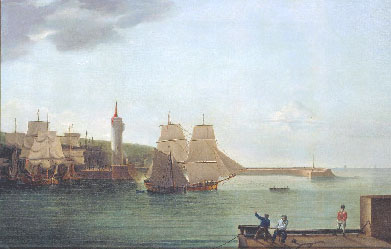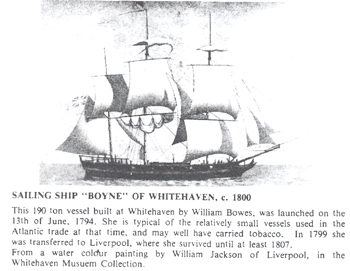|
Notes on
Whitehaven Harbour and Marina
by former Harbourmaster, the late Mr Neil Foskett
written circa 2008.
The 17th
century, historical, substantially built Harbour, offers a quality, fully
serviced Marina. It was opened in 1997 and awarded Blue Flag status in
2003. With near 24-hour access, Whitehaven Marina is set to become the
North West of England's premier cruising harbour of the 21st century.
Whitehaven
is uniquely situated at the South Western entrance to the Solway Firth
and is ideally placed geographically to offer boat owners a superb departure
point for the Isle of Man, Ireland, Southern Scotland, Clyde and Hebridean
cruising or even a departure point for transatlantic cruising.
The
Town and Harbour is also situated on the Western Lake District Coast,
and is the ideal place to stay if you fancy a few nights in the Lakes.
England's highest mountain, deepest lake and smallest church are within
a 30-minute drive together with Muncaster Castle, the Ravenglass &
Eskdale Railway, Cockermouth and Keswick. Within 1 hour you will be in
the heart of the Lake District and able to explore Grasmere, Ambleside
and Windermere.
(Shipbuilding at Whitehaven
and how they took elephants to Australia!)
Whitehaven
has a wealth of Georgian architecture and was one of the first post-medieval
planned towns. It has a number of high quality visitor attractions such
as The Rum Story, The Beacon and Haig Colliery Mining Museum. Whitehaven
also hosts regular Maritime
Festivals, which attracts over 200,000 visitors, having commenced
in 1999.
We most
sincerely hope that you enjoy your stay with us be it long term or just
a short stay. We are here to help you in any way we can, so please fell
free to contact any member of staff should you have a problem or query.·
The first quay to be built was the Old Quay in 1633. This was for the
export of salt & coal.
· All the Quays within the Harbour are set on a foundation of squared
oak. · In 1700 80% of all Irelands coal was imported from Whitehaven.
· By 1730 Whitehaven had the deepest coalmines in the world, some
running beneath the sea.
· By the beginning of the 18th century Whitehaven was importing
large quantities of tobacco from Virginia and Maryland in exchange for
manufactured goods.
· Imports at this time from the West Indies included sugar, spirits
slaves! (See the 'Rum Story', Lowther Street for the story of this nefarious
trade).
· The slave & tobacco trade ceased during the American War
of Independence.
· Over 1000 ships are documented as built in the port of Whitehaven
ranging between 150 & 3000 tons burden.
· The second quay to be built was the Bulwark Quay, (Marina car
parking). This quay was first built to the south end of the harbour, demolished
and rebuilt in its present position in 1711.

· Due to the dramatic increase in trade the Sugar Tongue was built
in 1734 in exactly the same place as the original Bulwark Quay had once
stood.
·
A Pier Master, forerunner to the Harbour Master was first employed in
1709 as the port became busier. The Pier Masters House was built in 1764
to accommodate him close to the port.
This building during later years became a public house. It is planned
to bring the building back to its former glory.
· Whilst the Pier Master worked the port, it is known that 2 press
gangs operated within the town of Whitehaven.
· John Paul Jones raided the port of Whitehaven on 23rd April 1778.
The full story can be gleaned from The Beacon Heritage Centre South of
the Harbour.
· Three of the original cannons used to repel the attack can be
seen on the West Strand complete with bronze sculpture of a sailor 'spiking'
the touch hole.By 1832 the outer harbour had been built at a cost of £150,000,
a fraction of the cost today for such prominent walls. Both piers took
25 years to build.
The West Pier Lighthouse was built in 1832. Almost unbelievably the Harbour
Commissioners at the time were reluctant to build it. Only the shipmasters
constant demands finally changed their minds.
·
Railway locomotives were a common site on the harbour side by the late
19th century. They were first introduced in 1848, the last locomotive
being disposed of in 1986.
·
By 1860 over 400 wagons per day were using the Sugar Tongue to load and
off load produce.
·
By late 19th century almost all of the Harbour had a rail network, even
to the tip of the West Pier. The coal chutes or hurries, in the Harbour
Walls can still be seen in the North Harbour.
·
The steam locomotives were housed on the West Wall near to the Queens
Dock gates. The steel shed still stands today. It is not known what will
happen to the shed as redevelopment on the Bulwark Quay is to be undertaken
in the near future.
·
In 1876 the Queens Dock was built. This was a wet dock with one set of
dock gates to hold the water in as the tide ebbed. The original wooden
gates were replaced with steel gates in 1938. These gates can still be
seen today. In 1999 trespassers accessing the electric motors inadvertently
activated these old gates and they actually closed after all this time.
Thankfully the Harbour staff were able to open them again and this time
they were completely de-commissioned.
·
In 1900, 72,000 tons of silt was dredged from the outer harbour. The cranes
that used to tower over the Queens Dock were a much later addition to
the harbour. They were erected in 1976 for the handling of phosphate rock.
This trade has since terminated and the cranes have now been dismantled.
· Today the main trade of Whitehaven Harbour is fishing & leisure
craft.
· Access was greatly improved to the port by the installation of
a £6.7 million Sealock in 1998. The Sealocks main purpose is to
protect the town of Whitehaven from tidal flooding, this having been a
common occurrence prior to the installation.
· The Marina was built in conjunction with the Sealock and has
gone from strength to strength. Plans for refurbishment of the Bulwark
Quay to compliment the Marina facility are well underway to complement
the recent total upgrading of the Harbour side.
Despite the down turn in the fishing industry within the UK, Whitehaven
has seen a dramatic increase in this trade. · The main landings
comprise of prawns & scallops said to be of the finest quality in
Britain. Other landings include plaice, sole, lobster, crab, dogfish,
whiting and even the odd shark. · At this time some 25 fish landing
agents servicing the fishing fleet operate through Whitehaven Harbour.
The notes
above only skim the surface of a fascinating history between Town &
Harbour. All the subjects can be explored too much greater detail in and
around the town and certain aspects are always being discovered. Such
a case recently occurred during the recent works to improve the harbour
surfaces. Whilst digging near to the north east corner of the Harbour
with a JCB, the ground opened up to reveal a perfectly cut sandstone tunnel
/ culvert big enough to stand in leading from deep in Queens Dock up under
the town. It is blocked at the eastern end and had remained undiscovered
and forgotten.
 Who
knows what lies in store for Whitehaven Harbour? With a colourful 400-year-old
history. The recent improvements to the fishing industry, harbour infrastructure
and continuing developments are sure to become yet another chapter in
its long & majestic life. Who
knows what lies in store for Whitehaven Harbour? With a colourful 400-year-old
history. The recent improvements to the fishing industry, harbour infrastructure
and continuing developments are sure to become yet another chapter in
its long & majestic life.
Perhaps
in an other 400 years some future Harbour Master will be writing about
these times with as much enthusiasm as I am here.
I sincerely hope that you enjoy your time on the Solway coast. West Cumbria
has a lot to offer everyone with the beautiful Lake District nearby, but
do ensure that you save some special time for our town of Whitehaven.
The late Neil Foskett
- former Harbour Master
Radio Call Sign 'Whitehaven Harbour'
Marine VHF Channel 12
(licensed frequency for the Harbour)
Opening
hours:
24 hours a day, 365 days a year. Please contact
Whitehaven Marina Company
for more information.
|


